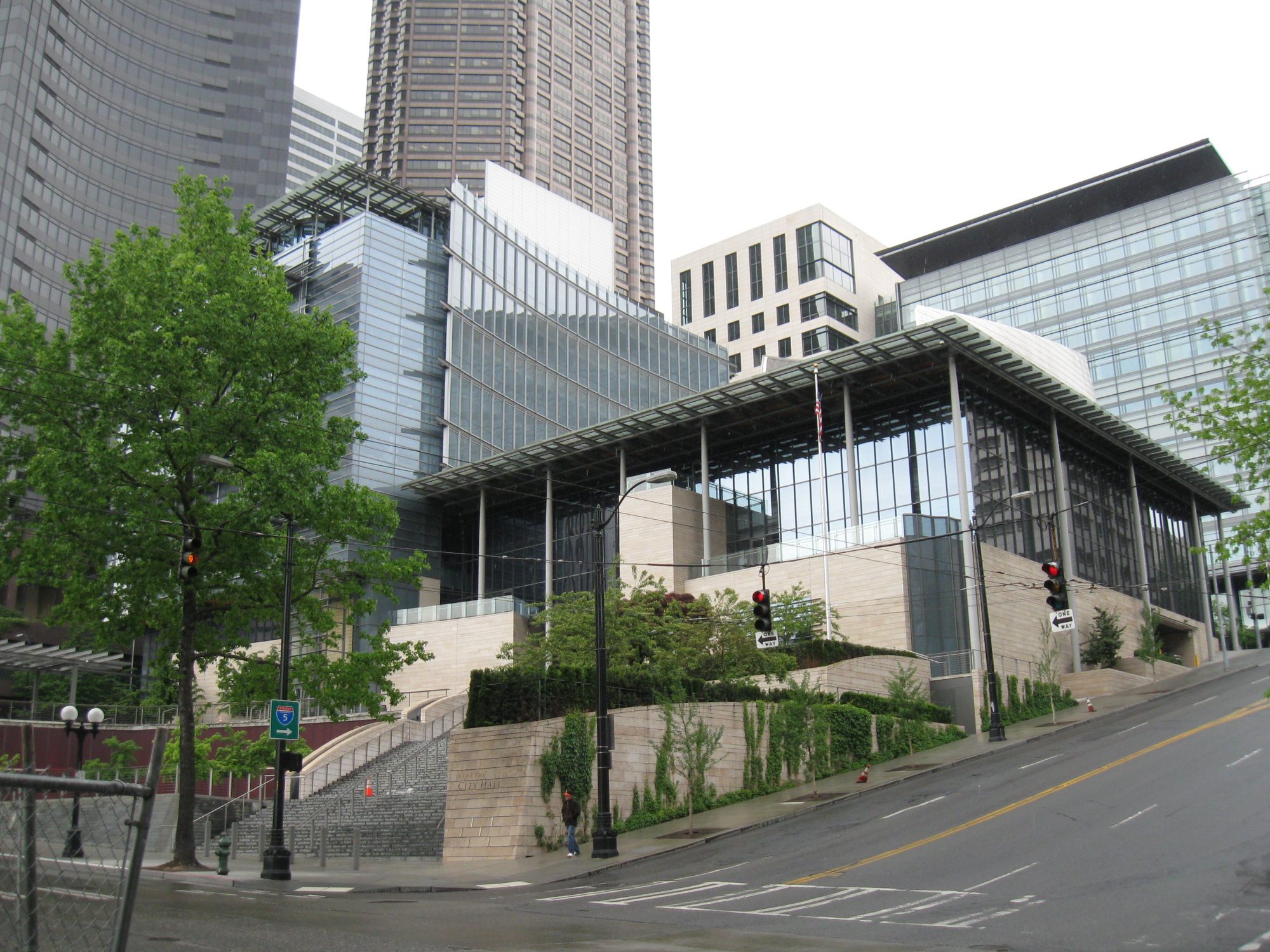On Monday, the Seattle City Council adopted several pieces of legislation related to land use, housing, education, and the environment. While the education levy proposition is undoubtedly the marquee headline from the meeting, the city council approved more funding–though temporary–for homeless emergency services and housing that could benefit hundreds of individuals living on Seattle’s streets. The city council also adopted a 167-page omnibus Land Use Code bill and legislation to make it easier to fine noise violations by motorists.
Bridge Housing and Shelter
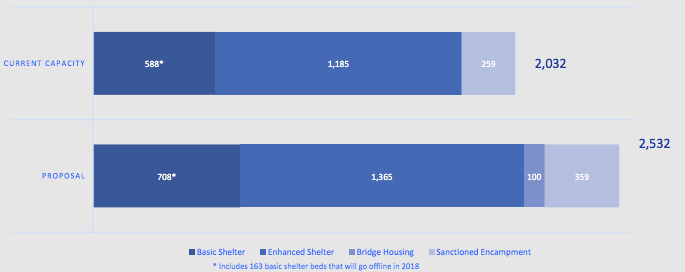
Following closely on the heels of its move to repeal the head tax‘s $47.5 million per year stream of funding, the city council made a consequential commitment to people experiencing homelessness in Seattle for the remainder of the year. The bill authorized $6.32 million in budgetary spending to help implement the Bridge Housing Investment Strategy and added four full-time staff to the Human Services Department rosters. Funding comes from existing city reserves.
The Bridge Housing Investment Strategy increases bridge housing and shelter by 25%. That translates to about 525 more people who can be provided with shelter each night in Seattle and keeps 163 basic shelter beds operating that would have gone offline. The investment break down into:
- 120 more spaces for basic shelter;
- 180 more spaces for enhanced shelter;
- 100 new spaces for bridge housing; and
- 100 more spaces in sanctioned encampments.
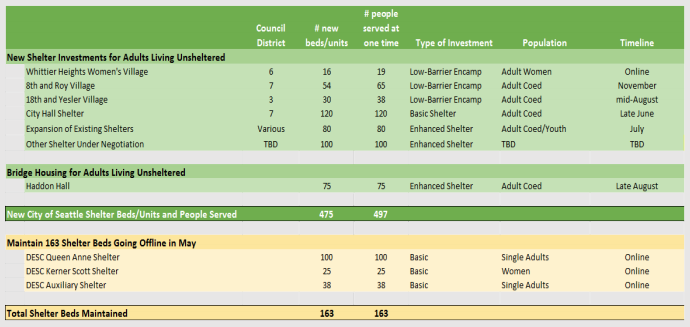
Over the next several months, more shelter spaces will open up across the city to individuals experiencing homelessness. City hall will provide 120 additional beds by month’s end followed by 80 beds by expanding existing shelters in July. The city also expects to add 30 homes at the Yesler Tiny Home Village by mid-August and 75 “bridge housing” beds at Haddon Hall in late August. The city council also restored funding to three DESC shelters, which will keep 163 beds open. These DESC shelters had lost funding because they didn’t score well in the new metrics suggested in the Poppe report that emphasized rate of success in getting people into permanent housing.
Omnibus Land Use Code Bill
The bi-annual omnibus Land Use Code bill was passed. The bill generally makes technical corrections, such as fixes to errors and omissions to recently adopted ordinances, improves readability, and harmonizes code citations and formatting. However, the bill invariably involves some policy changes.
The city council deliberated over some significant policy adjustments, such as design review exemptions for rowhouses, additional non-residential square footage in the DOC2 zone above the ordinary maximum height limit, and calculation of tower separation in a limited circumstance:
- Language had been proposed to the design review program to incentivize rowhouse development by fully exempting projects under 15,000 square feet of gross floor area from design review. Councilmember Lisa Herbold sponsored an amendment to remove this change from the bill, which was adopted leaving the status quo in force.
- Councilmember Rob Johnson sponsored an amendment to allow an additional 40,000 square feet of non-residential uses above the ordinary maximum height for non-residential uses in the Downtown Office Core 2 (DOC2) 500/300-550 zone, up to 640 feet, if the structure is designed to be thin. The allowance could be used alone or in combination with a similar incentive for residential uses. The amendment was adopted.
- Councilmember Johnson also sponsored an amendment to correct an error in the bill and add conditions to aforementioned DOC2 500-300/550 zone incentive. An earlier version of the bill would have rezoned DOC2 500-300/550 to DOC2 550-300/550, but that was pulled in the substitute bill. The amendment corrected the zoning reference and added a condition that portions of a structure above 85 feet must be at least 45 feet from existing towers, except that decks, balconies, and other architectural projects need not be calculated in the separation requirement. The amendment was adopted.
To give a sense of some policy changes made through the omnibus bill, here are four examples:
- New categorical exemptions under the State Environmental State Policy Act added include rehabilitation and replacement of structurally deficient bridges, installation of transit-only lanes, and construction of wayfinding signs.
- New heliport standards and separation requirements will apply in Seattle Mixed zones, consistent with similar language for Downtown zones.
- Podium height standards in South Lake Union zones were slightly modified by eliminating them entirely the western half of blocks situated between Aurora Ave N and Dexter Ave N. The revised podium height standards also modify the heights applicable to the Teardrop site owned by the city, requiring three different heights depending upon frontage.
- In commercial zones, live-work units will be required to face a street and have visually prominent pedestrian entrances that provide direct access to non-residential portions of the units.
Reducing Vehicle Noise
The city council acted to abate noise from vehicle exhaust sources. The primary purpose of the law is to discourage cruising with amplified and unusual noise from vehicles. For instance, some motorists choose to modify their mufflers to produce loud combustion noises, which are highly disruptive and harm people with hearing sensitivities.
Traffic noise citations have been falling for the past seven years, but not because violations are actually going down. Enforceability is the problem. Current law only allows citation if a vehicle exceeds 95 decibels. Police must use devices to measure the noise level, which makes it difficult to cite offenders. New city law will allow police to cite drivers who produce audible motor sounds 75 feet away or more from the roadway. The law will be enforced actively in Alki through the local community policing plan. Whether or not the law will be implemented citywide is still unclear.
Education Levy
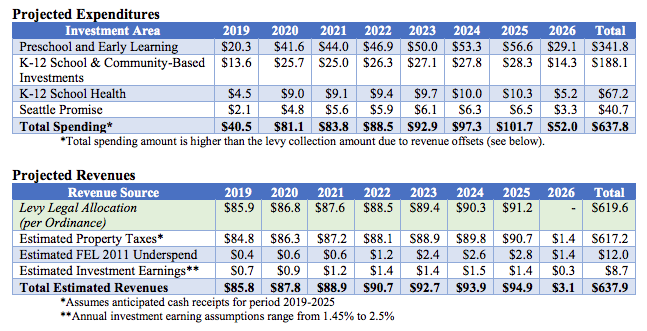
The city council approved a proposition to reauthorize the citywide Families, Education, Preschool, and Promise (FEPP) Levy. The levy provides for in-school healthcare programs, free two-year community college tuition for graduating public high school students, additional public school programs, and free preschool for qualifying families and early learning programs. The levy would raise $637.9 million from 2019 through 2026. A corresponding resolution dictates several line-items on how revenues should be spent and the actions to be taken by the Mayor and Seattle Department of Education and Early Learning:
- $4 million for the childcare mentorship program;
- $2.8 million for childcare vouchers for homeless children;
- $56 million for summer school, school-based investments, and other learning opportunities for students at the elementary level;
- $14.5 million to provide family support workers (up to 15 full-time employees);
- $12.9 million for general opportunity and access investments in primary and secondary schools; and
- $1.4 million to a new healthcare center at Nova High School.
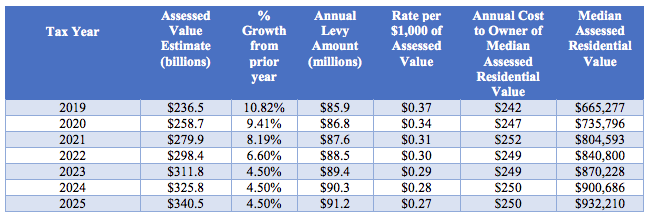
The average homeowner should see the levy rate fall in the subsequent years as housing prices continue to skyrocket. Assessments will likely top out at $250 per year for the average homeowner. Overall, the average homeowners can expect to pay $20.70 per month, that’s $9.36 more than now. The projections for average housing prices, however, is a grim reminder that the housing crisis is tremendously dire. The proposition will appear on Seattle voters’ ballots in November and only needs a simple majority to pass.
Stephen is a professional urban planner in Puget Sound with a passion for sustainable, livable, and diverse cities. He is especially interested in how policies, regulations, and programs can promote positive outcomes for communities. With stints in great cities like Bellingham and Cork, Stephen currently lives in Seattle. He primarily covers land use and transportation issues and has been with The Urbanist since 2014.

